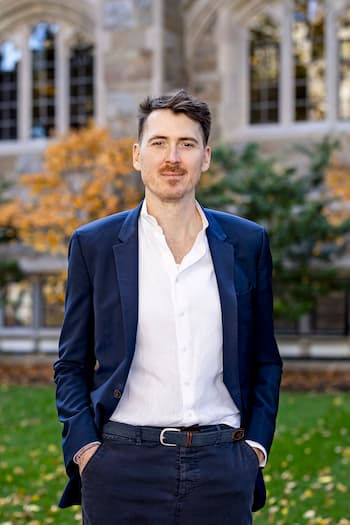

Assistant Professor, Medieval Art

Devlin Hall, 424
Telephone: 617-552-4295
Email: john.lansdowne@bc.edu
John Lansdowne specializes in medieval and early modern art in Europe and the Mediterranean basin, with a particular focus on exchanges in the later Middle Ages between Western Christendom and the wider East Christian and Islamic worlds. Major elements of his research investigate the new meanings that objects and images accrue when brought into different cultural or ideological contexts and premodern paradigms for issues in contemporary culture and society.
At BC, he teaches across a wide chronological and geographical range, traversing the Middle Ages in Europe, the Mediterranean, Northeast Africa, and the Middle East. Many of his courses bridge the broader ancient, medieval, and early modern epochs, and he welcomes students in all disciplinary specializations.
Lansdowne’s writing has appeared in numerous venues, outlined below. His article “Compounding Greekness” (Gesta 2021) was awarded the 2023 Van Courtlandt Elliott Prize from the Medieval Academy of America. His current book project, Fraction = Union, examines visual allegories for ecumenical union—the fraught geopolitical and interreligious enterprise to unite all peoples and nations into an undivided “worldwide” Church. In addition, he co-leads a major project on portable mosaic artifacts, a collaboration among art historians, conservators, image scientists, and materials scientists initiated at Dumbarton Oaks Research Library and Collection in 2023.
Beyond BC, Lansdowne’s work draws from extensive field, archival, and object-based research overseas, most especially in Italy, Turkey, and Greece. As a predoctoral candidate, he lived in Rome for three years, first at the Bibliotheca Hertziana (Max-Planck-Institut für Kunstgeschichte), and next at the American Academy in Rome, where he held the Rome Prize in Medieval Studies for 2015–2017. After receiving his Ph.D., he held the 2019–2020 Andrew W. Mellon Postdoctoral Fellowship in Byzantine Studies at Boğaziçi University in Istanbul, followed by a National Endowment for the Humanities (NEH) Postdoctoral Fellowship via the American School of Classical Studies at Athens. From 2021 to 2024, he was based at Villa I Tatti, The Harvard University Center for Italian Renaissance Studies in Florence, initially as a Berenson Fellow—designed to support scholarship on “Italy in the World”—and then as Assistant to the Director, a post he held for five terms. Other institutions to support his work include the Seeger ’52 Center for Hellenic Studies at Princeton, the Pontifical Institute of Mediaeval Studies, the Delmas Foundation, BC’s Institute for the Liberal Arts, and Dumbarton Oaks.
Professor Lansdowne is a BC alumnus, having studied History and Classics with Professor Gail Hoffman. He received an M.Phil. in Classical Archaeology from St Cross College, Oxford and his Ph.D. from the Department of Art & Archaeology at Princeton University.
“Narrative to Icon: The Inscriptive Origins of Christ Ecce Homo.” Word & Image, vol. 40, no. 3 (2024): 201–219.
“Giordano da Pisa: Remarks on the Authority of Icons from Greece (1306).” The Visual Culture of Later Byzantium (1081–c.1350), ed. Foteini Spingou, Sources for Byzantine Art History 3 (New York and Cambridge, UK: Cambridge University Press, 2022), 1.887–897.
“Compounding Greekness: St. Katherine ‘the Egyptian’ and the Santa Croce Micromosaic.” Gesta, vol. 60, no. 2 (Fall 2021): 173–215 [awarded the Van Courtlandt Elliott Prize from the Medieval Academy of America]. [LINK]
“Hagia Sophia takes centre stage in the battle over Turkey’s past.” Apollo (30 June 2020). [LINK]
Essay in “A Questionnaire on Monuments.” October 165 (Summer, 2018): 85–87. [LINK]
TRANSLATIO / Emily Jacir: Via Crucis. Rome: NERO, 2016 [designed and edited with artist Emily Jacir and historian Christopher MacEvitt; 116 pages; ISBN: 8897503942]; “The Truth in Material Things,” op. cit., 4–16. [LINK]
“Weapons for Remembering.” Enrico Riley: Infinite Receptors, exh. cat., Jaffe-Friede Gallery, Dartmouth College (Hanover, NH: Trustees of Dartmouth College, 2017), 24–27. [LINK]
“Kara’s Dust.” The Ecstasy of St. Kara / Kara Walker: New Works, exh. cat., Cleveland Museum of Art, ed. Beau Rutland and Reto Thüring (New Haven and London: Yale University Press, 2016), 30–33. [LINK]
“Flesh, Visual Arts”; “Gems/Gemstones, Visual Arts”; “Heavenly Ladder, Visual Arts.” Entries in The Encyclopedia of the Bible and Its Reception, 30 vols., ed. Dale C. Allison, Jr. et al. (Berlin: DeGruyter, 2014–2015), 9.189–190; 9.1102–1103; 11.596–597.
“Echoes of Constantinople’s Apostoleion in Late Antique Italia Annonaria.” The Byzantinist, vol. 1, no. 1 (2011): 4–5; 15.